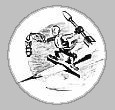| While Stuart Simmons, 80, quietly relaxes at his hobby of wood carving, his mind wanders back to more exciting times in his life. Like many men his age, he served in the military during World War II and the experiences will burn in his memory as long as he lives.
His young life started quietly enough as he graduated from Franklinton High School in 1936, and then went on to Louisiana Tech in Ruston for three years. He was employed by the state highway department in highway and road design.
But one fateful day his young life changed. His boss asked him to carry the mail by the post office and a Navy recruiter on duty at the post office talked him into joining the Naval Air Force.
Mr. Simmons became a member of our Air group 87 . The Insignia on the left is of Carrier Air Group (CVG) 87, which flew from the deck of the USS Ticonderoga CV-14 during the final months of World War II. The dagger represents Torpedo Squadron (VT) 87, the bomb poured from the bottle of poison represents Bombing Squadron (VB) 87, and the rocket toting leopard represents Fighting Squadron (VF) 87 and Bombing Fighting Squadron (VBF) 87.

CAG 87 |

VF(N) nightfighter |
Simmons enlisted Sept. 2, 1941 as a Seaman 2/C AVN (Navy aviation) and was sent for training to the Auxiliary Naval Air Station, New Orleans Elimination Base, where he received flight instruction along with drill and radio-training. He had his solo up-check after nine hours instruction. He was then sent to the Naval Air Station in Corpus Christi, TX, where he was appointed an Aviation Cadet in December, 1941.
After his training was completed, he received his commission as an ensign and naval aviator in July, 1942. He enjoyed about three weeks of leave before being ordered to a naval air base in Oakland, CA and assigned to Scouting Squadron VS-58. He began sea plane training in OS2U's and embarked by transport ship to the New Hebrides Islands in the South Pacific in September, 1942. There they had to construct their own ramps to the sea, Quonset huts and whatever else was necessary to live. VS-58 was a scouting and anti-submarine patrol to escort troops and supply ships to the north. They sank four enemy submarines during his tour with that group.
Simmons returned to the States in April 1944, married, and then chose training as a fighter carrier and night fighter in the F6F Hellcat. He went through some very strict training to be a "Night Bird". Simmons says their training was strenuous, precise, and dangerous. A few pilots were lost. This training was done in Florida. Simmons was then sent to the Quonset Point, RI, Naval Air Station for more night flying and night carrier landings.
He recalled that one pilot crashed during night carrier landing practice and froze to death in the sea before he could be rescued. After such incidents as this, they were transferred to Key West, FL where the climate was more like the South Pacific, to which they were being sent. After this completion, about 30 "Bat-Men" were sent to Oahu,Hawaii in the Pacific for more night flying, radar interception problems and gunnery practice.
He was then sent to VF-8 Squadron 87 along with seven other VF navy pilots on the USS Ticonderoga, Task Force 58, Fifth Fleet under Rear Admiral Sprague, USN. He was assigned as senior night fighter pilot on this ship. Each carrier had only eight VF(N) pilots aboard. The Third Fleet under Rear Admiral Halsey relieved the Fifth Fleet shortly thereafter and consisted of Ticonderoga, Yorktown, Shangri-La and Independence carriers, along with battle ships, cruisers, and destroyers. This fleet began combat north to Tokyo and Hokkaido, which lasted from May, 1945 until the end of the Pacific War.
Simmons remembered that during one incident in combat he and his wingman saw a "bogey" (enemy) just at dark approaching the fleet. They were ordered to attack and as they closed in, the enemy pilot got a visual on them and dove into the sea. He said during the end of the war the enemy pilots were young and didn't know how to fly in an evasive way and had not been trained in the proper maneuvers. Simmons was given credit for shooting down three and one-half planes.
Air Group 87 aboard the Ticon-deroga was credited with sinking the battleship Hyuga, three merchant ships, 34 planes destroyed, and 61 combat strikes on many Islands and airfields. Simmons came back to the States in October, 1945 on the CVN Ranger Carrier USS Wasp. On Navy Day, Oct. 27, 1945 aboard the CVN Ranger, they arrived in New Orleans. He was discharged Dec. 1, 1945 from United States Navy and was in the reserve until 1956. Simmons was in active duty four years and three months, retiring as a Lieutenant.
After being discharged, Simmons again worked for the Department of Highways with the location and survey section. When he had graduated from Franklinton High School in 1936, he received the American Legion Award, one of the highest honors given to graduating seniors. He proudly displays this medal on his American Legion cap. He is an active member of the Homer Magee Post 113, American Legion. After retirement, Simmons developed the hobby of wood-carving, which he enjoys very much. The objects he has carved are on display in his home and are a work of art. As he carves, he remembers. An exciting time for a young man, but one he wouldn't care to repeat ...except in his memory.
|